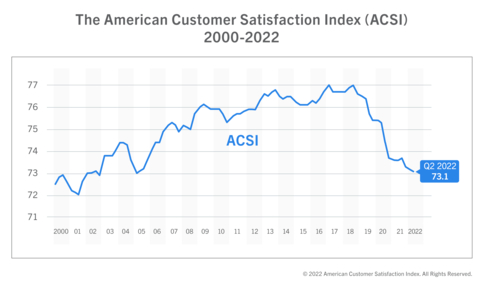Is Low Customer Satisfaction the Inflation Antidote?
The latest quarterly American Customer Satisfaction Index (ACSI) shows that customer satisfaction in the United States continues to fall. Not only has it declined for three consecutive quarters; it has plunged by 5 percent since 2018—the largest descent in the 28-year history of ACSI. It now stands at 73.1 (on a 100-point scale) and has slumped in 12 of the past 15 quarters.

At the same time, America's gross domestic product (GDP) has declined for the past two quarters as well. In fact, the overall pattern is similar to what happened during the 2009 financial crisis and the emergence of COVID-19 in 2020: Both GDP and ACSI decreased.
However, according to the ACSI, what we have now is different and more complicated than previous economic contractions. It is unusual that both quantity and quality of economic output, as reflected by GDP and ACSI respectively, fall in a strong labor market. It is also unusual that consumer spending is increasing. Not only is consumer spending the largest component in GDP, but it is also associated with increasing, not decreasing, customer satisfaction.
To make things worse, inflation is probably even higher than reported because it is not fully adjusted for the decline in quality, especially in services, as evidenced by the ACSI data.
"Increasing interest rates is the conventional prescription for curbing inflation and cooling an overheated market. Yet, the current economic situation presents unconventional challenges," said Claes Fornell, founder of the ACSI and a retired professor of business administration at the University of Michigan. "If shortages, shipping problems, labor shortages, and other supply issues are causing demand to be greater than supply, prices may continue to spiral upwards. Paradoxically perhaps, customer satisfaction will then matter less for business. In a shortage economy, companies don't need to compete much for customers. Rather, consumers compete with one another to be first in line and to get what's available."
At the same time, some industries now suffer from the opposite problem: Overstocking with more inventory than warranted by demand. Thus, prices will come down for some products.
While strong demand due to high levels of customer satisfaction tends to increase companies' pricing power, the same is true in a shortage economy, but regardless of customer satisfaction. That is, both overstocking and falling customer satisfaction put pressure on price.
The paradox here is that falling customer satisfaction might help curb inflation, but only in sectors without supply problems.
However, the industries that have seen the sharpest drops in customer satisfaction also have supply constraints, mostly with respect to labor. Examples are hospitals (-9 percent), hotels (-7 percent), and express delivery (-9 percent). Industries with large price increases also have more dissatisfied customers—for example, gas stations (-8 percent), beer (-7 percent), and utilities (-5 percent).
At the opposite end of the spectrum are industries that depend less on service. To the extent that they can avoid having customers actually requiring service, they have seen an increase in ACSI—for example, customer satisfaction for cable television is up by almost 7 percent, internet services by 3 percent, and personal computers by 3 percent.